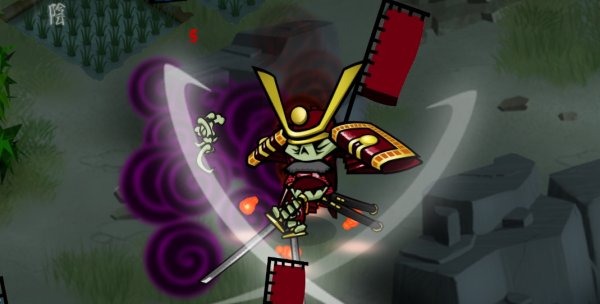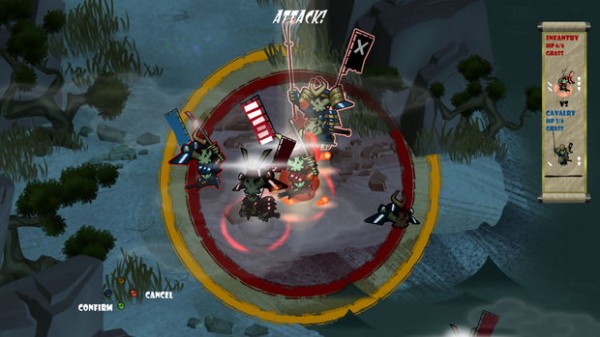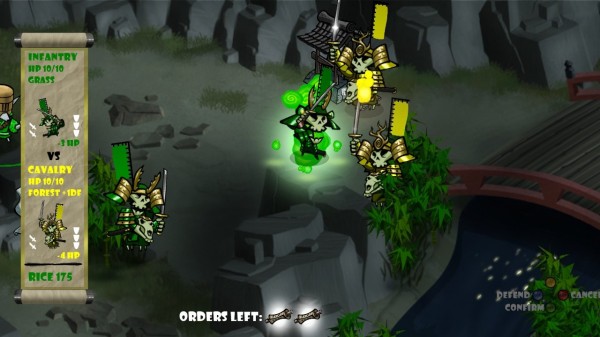Skulls of the Shogun: Comedy is the Best Revenge
Video games have long made life after death a very diverse drag to say the least. From the loose, graphic interpretation of Dante’s Inferno to less disturbing (yet no less tragic) fates of those in Final Fantasy X doomed to monsterhood without a summoner’s sending. Haunted Temple Studios thankfully is making death a lot more enjoyable.
The tone is set very early in the demo build here at Fantastic Arcade. Fallen samurai general Akamoto finds himself missing one of his swords and waiting in a line outside a temple for entry into the afterlife like a Jersey Shore cast member awaiting for entry into an A-list Hollywood party. His prospects look about as promising as he discovers most of whom he’s in a crowd with will never get in and are being tricked into calmly waiting what will never happen to maintain order. This revelation predictably angers the deceased general whom sets off in recruiting other to fight their way into the underworld and also confront a mysterious imposter. The story it its core taps inspiration from revenge tales but mixes that serious storytelling into a more light-hearted universe.
Ben Vance, a programmer with seven years experience with triple-A game development, did most of the writing in the game and says much of the tone came from the Haunted Temple team wanting to put together a game that was a love song to classic strategy games with it’s own unique flair. “All of us are enamored with Japan and [Skulls artist and director Jake Kazdal] actually lived there for five years,” said Vance. “The idea [was] bringing a Japanese mythology to a Western audience and making an art style that marries East and Western design and hopefully make it appeal to people on both Eastern and Western parts of the world.”
As such, Kazdal used his love for games such as Advance Wars and samurai as a start and the game evolved from there. From there, the team felt dead samurai would make for a more appealing subject matter. And the humorous tone in part came from the visual tone Hunted Temple adopted. “The art style of the game is sort of fun to look at. The characters are cartoony and they are sort of influenced by urban character design, vinyl toys, that sort of stuff,” Vance said. “From very early on we always knew it would be kind of goofy. We wanted to have fun with it. We wanted people to have fun with it.”
For what improvement the element has seen in recent years, one would be hard-pressed to find any consensus saying writing and video games is great as whole. Comedy, being one of more difficult forms of creative writing, often really suffers. Vance admits finding what works is often a hit and miss endeavor, but still enjoys it. “That’s been a fun process of trying out difference jokes and discovering what people react to. A lot of that has been I’ll throw something in because I think it’s kind of funny and the guys will see it and they’ll be like, ‘That was awesome! I fell out of my seat, almost.’ You don’t get that reaction very often but that’s one of the things we try and shoot for if at all possible. Humor is hard to do in games. There’s not a lot of games that do it really well.”
Vance feels both timing and time are critical elements of hitting the proper comic beats. He said Haunted Temple has been attempting to put in the extra time to get the details from camera movement to delivery. Those details must come together cohesively to make comedy work. “If something goes a little too long or a little too short or you miss the [right] beat sometimes it doesn’t work as well. … If you don’t spend the time on it, it’s not going to be funny. It’s not going to connect with anybody.”
As with any other part of game design, Vance feels comedy has to be an integral part of the game design to really work. It can’t be a second-class citizen. Many times, they would start a scenario thinking about what could be funny about an idea that may come to mind. Often the studio would find something that may make sense within the context of the game world but is outright ridiculous to the player. For this element, Vance believes the the small size of the team — Haunted Temple consists of three full time members and a slew of collaborators — makes pulling the comedy into the game design easier.
“We’re small to where we can communicate to each other — we only have two other people — to make a decision. We can work through these things. I’m doing a lot of the writing and scripting myself so I can sit down with a level and say ‘What are the story events that happen in this level? What do we want the outcomes to be? What things do we need to explain and what room is there for jokes?’ “
Wheres Vance can handle much of that himself, in a bigger studio the person writing the dialogue may working with some distance from the level designer whom may not be collaborating the the person character designer whom may work independent of the scripter. Someone has to be the steward of all those elements and one person handling many of them may keep the overall vision together better than a group of several working on different elements. The result is story and comedy crafted into the game design decision as opposed to being thrust upon each other.




